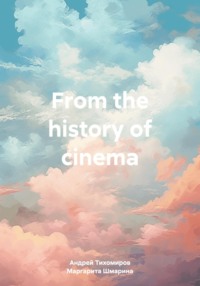Kitobni o'qish: «From the history of cinema»
The emergence of cinema
Cinematography (from the Greek words "movement" and "I write") is an apparatus for shooting objects in motion on photosensitive film and for subsequent reproduction of the images obtained by projecting them onto the screen, as well as a spectacle based on the use of this apparatus.
As a result of shooting with the help of cinematography and appropriate laboratory processing of photosensitive material, a motion picture is obtained – a series of images fixed on film depicting successive phases of the object's movement or changes in its state. Reproduction of the obtained images is achieved by shining through the film with a diverging beam of light rays directed at the screen, on which an enlarged image of the frames shot on film is formed. With intermittent motion of the film in the cinema and a certain frame rate, the motion of the captured objects is reproduced.
Cinematography appeared as a result of a combination of a number of inventions that made it possible to carry out the basic processes necessary to reproduce photographed motion: chronophotography (which gives a series of snapshots of successive phases of motion) on photosensitive film, projection of images onto the screen and intermittent movement of the film during filming and projection.
"Chronophotographic devices that took pictures with considerable frequency were designed in the 80s—90s of the 19th century. These include the "photographic weapon" by the French physiologist E. Marey (1882), the apparatus of the English inventor W. Friese-Green (1889), the apparatus of the Russian photographer V. A. Dubuque (1891), the "phonoscope" by the French physiologist J. Demeny (1892), "kinetograph" by the American inventor T. Edison (1893), chronophotographic apparatus and "stereokineograph" by the Russian photographer I. Yanovsky (1894) and others.
Flexible photosensitive film was invented: non-flammable – by the Russian photographer I. V. Boldyrev (1878-1881) and combustible, celluloid – by the American inventor J. At the same time, devices for projecting rapidly changing images onto the screen appeared: the tachiscope by the German photographer O. Anschutz (1891), the same apparatus by V. A. Dubyuk (1891), the optical theater by the French inventor E. Reynaud (1892), the kinetoscope by the Russian inventors I. A. Timchenko and M. F. Freudenberg (1893), etc. A device for intermittent movement of film – a jump mechanism of the "snail" type – was invented by the Russian mechanic I. A. Timchenko (1893).
The closest predecessors of cinematography were the "apparatus for analyzing stroboscopic phenomena" I. A. Timchenko (1893), which combined projection on the screen with intermittent image change; "chronophotograph" J. Demeny, which combined chronophotography on film and projection on the screen (1894); created by the American inventor W. Latham (1895) "panopticon", which combined chronophotography with projection on the screen, etc.
The device, which combined all the basic elements of cinematography, was invented in France by the brothers O. and L. Lumiere (1895), J. Demeny (1895); in Germany – M. Skladanovsky (1895), O. Mester (1896); in England – R. Pole (1896); in In Russia – A. Samarsky (1896), I. Akimov (1896), in the USA – F. Jenkins (1897), T. Armat (1897)" (The Great Soviet Encyclopedia, the State Scientific Publishing House "The Great Soviet Encyclopedia", 2nd edition, editor-in-chief B.A. Vvedensky, volume 20, 1953, p. 637).
M. Skladanovsky demonstrated his cinematography on November 1, 1895 in Berlin, and the Lumiere brothers in Paris on December 28, 1895. The subsequent trips of representatives of the Lumiere brothers with cinematography to various countries contributed to the spread of the "Lumiere cinematography" and quickly created wide fame for this art form.
Their most famous film is "The arrival of the train at La Ciotat station" ("L'Arrivée d'un train en gare de la Ciotat", 1895). In Russia, it is also known by the names "Arrival of the train" and "Arrival of the mail train". The plot is quite simple – in 49 seconds, a train stop at La Ciotat station and passengers walking along the carriages are demonstrated. This film became the progenitor of the silent film plot, which was called "stray". Directors all over the world began to reproduce it and shoot their versions at different train stations
The very first film in the world – "Scenes in the Roundhay Garden"
Frenchman Louis le Prince, the author of this film, used a new technology for that time: the recording was on paper film with an emulsion applied to it. The duration of the scene is only 1.66 seconds, and Louis captured a walk in the garden of his son, mother-in-law with her husband and friend Harriet Hartley.
The first film with sound is "The Jazz Singer"
Sound recording technology (phonograph) already existed before the advent of cinema. In 1894, Thomas Edison and his assistant William Dixon made the first attempts to introduce sound recording into a movie camera. But the invention (kinetophonograph) remained only a technical incident due to the big problems in device synchronization and very low sound quality.
Leon Gaumont tried to repeat something similar in 1900: he combined the Lumiere apparatus with a phonograph. Nevertheless, the invention remained unsuitable for the birth of sound cinema for many years.
Technological progress required film directors to move forward: the popularity of radio had a bad effect on the flow of viewers to cinemas. Therefore, the introduction of audio accompaniment for films has become a necessity.
The first color film, "Journey to the Moon"
, Attempts to manually color films were made by the Lumiere brothers, but they themselves did not consider it a serious job, so there were no mentions of specific paintings in history.
